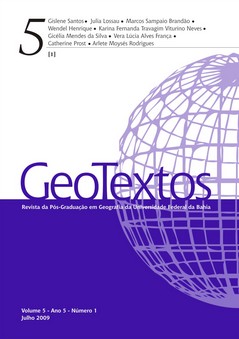THE ROLE OF THE INSTALLATION OF UFRB, THE ACTION OF MONUMENTA PROGRAM AND THE ETHNIC TOURISM IN THE URBAN RESTRUCTURING AND EVERYDAY LIFE OF CACHOEIRA-BA
PRELIMINARY APPOINTMENTS OF RESEARCH
DOI:
https://doi.org/10.9771/1984-5537geo.v5i1.3570Keywords:
Medium and small cities, Urban development, Historical citiesAbstract
In the region of the Reconcavo of Bahia, medium and small cities, older centers of the urban and regional economy, after decades of economic stagnation and population decline, receive attention from the Govern through programs and action which intend to rescue the lost economic development for the new knots of the urban system in this region. In Cachoeira (32,252 inhabitants) Federal and State programs and actions, as the campus of the Federal University of Reconcavo of Bahia(Ministry of Education), the Monumenta Program (Ministry of the Culture) and the Project of Ethnic Tourism (Ministry of Tourism), involving a great amount of investments, are implementing in order to promote the urban reorganization, requalification and refunctionalization of the historical buildings, generation of income and job, through the incentive of services and commerce linked to the offer of higher education and the tourism. The new inhabitants, as well as the new students, who pass just hours in the city and generally possess greater income than the local population, are stimulating the increase of the values of rent and acquisition of housing. We find an important modification in the job structure and in the infrastructure of the city, bringing new functions and services. Processes of economic and social exclusion, as well the segregation of part of the local population, are evidenced. The oldest inhabitants are in the border of the new urban, social and economic development.Downloads
Downloads
Published
How to Cite
Issue
Section
License
Autores que publicam nesta revista concordam com os seguintes termos:
Autores mantém os direitos autorais e concedem à revista o direito de primeira publicação, com o artigo simultaneamente licenciado sob a Licença Creative Commons Creative Commons CC BY que permite o compartilhamento do trabalho com reconhecimento da autoria e publicação inicial nesta revista. Esta licença permite que outros distribuam, remixem, adaptem e criem a partir do seu trabalho, mesmo para fins comerciais, desde que lhe atribuam o devido crédito pela criação original. É a licença mais flexível de todas as licenças disponíveis. É recomendada para maximizar a disseminação e uso dos materiais licenciados. Ver o resumo da licença em: https://creativecommons.org/licenses/by/4.0/ Ver o texto legal da licença em: https://creativecommons.org/licenses/by/4.0/ Consulte o site do Creative Commons: https://creativecommons.org/licenses/?lang=pt
Autores têm autorização para assumir contratos adicionais separadamente, para distribuição não-exclusiva da versão do trabalho publicada nesta revista (ex.: publicar em repositório institucional ou como capítulo de livro), com reconhecimento de autoria e publicação inicial nesta revista.
Autores têm permissão e são estimulados a publicar e distribuir seu trabalho online (ex.: em repositórios institucionais ou na sua página pessoal) a qualquer ponto antes ou durante o processo editorial, já que isso pode gerar alterações produtivas, bem como aumentar o impacto e a citação do trabalho publicado (Veja O Efeito do Acesso Livre).






